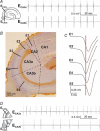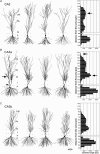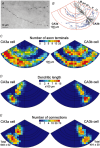Factors defining a pacemaker region for synchrony in the hippocampus
- PMID: 17823211
- PMCID: PMC2276992
- DOI: 10.1113/jphysiol.2007.138131
Factors defining a pacemaker region for synchrony in the hippocampus
Abstract
Synchronous activities of neuronal populations are often initiated in a pacemaker region and spread to recruit other regions. Here we examine factors that define a pacemaker site. The CA3a region acts as the pacemaker for disinhibition induced synchrony in guinea pig hippocampal slices and CA3b is a follower region. We found CA3a pyramidal cells were more excitable and fired in bursts more frequently than CA3b cells. CA3a cells had more complex dendritic arbors than CA3b cells especially in zones targetted by recurrent synapses. The product of the density of pyramidal cell axon terminals and dendritic lengths in innervated zones predicted a higher recurrent synaptic connectivity in the CA3a than in the CA3b region. We show that some CA3a cells but few CA3b cells behave as pacemaker cells by firing early during population events and by recruiting follower cells to fire. With a greater excitability and enhanced synaptic connectivity these CA3a cells may also possess initiating functions for other hippocampal ensemble activities initiated in this region.
Figures








Similar articles
-
Ensemble patterns of hippocampal CA3-CA1 neurons during sharp wave-associated population events.Neuron. 2000 Nov;28(2):585-94. doi: 10.1016/s0896-6273(00)00135-5. Neuron. 2000. PMID: 11144366
-
Threshold behavior in the initiation of hippocampal population bursts.Neuron. 2006 Jan 5;49(1):131-42. doi: 10.1016/j.neuron.2005.10.034. Neuron. 2006. PMID: 16387645
-
Variations in electrophysiological properties of hippocampal neurons in different subfields.Brain Res. 1982 Jun 24;242(2):341-4. doi: 10.1016/0006-8993(82)90320-1. Brain Res. 1982. PMID: 7116139
-
Distinct classes of pyramidal cells exhibit mutually exclusive firing patterns in hippocampal area CA3b.Hippocampus. 2008;18(4):411-24. doi: 10.1002/hipo.20404. Hippocampus. 2008. PMID: 18189311 Free PMC article.
-
Estrogen-mediated structural and functional synaptic plasticity in the female rat hippocampus.Horm Behav. 1998 Oct;34(2):140-8. doi: 10.1006/hbeh.1998.1466. Horm Behav. 1998. PMID: 9799624 Review.
Cited by
-
Spatiotemporal dynamics of high-K+-induced epileptiform discharges in hippocampal slice and the effects of valproate.Neurosci Bull. 2013 Feb;29(1):28-36. doi: 10.1007/s12264-013-1304-4. Epub 2013 Jan 30. Neurosci Bull. 2013. PMID: 23361520 Free PMC article.
-
Early Appearance and Spread of Fast Ripples in the Hippocampus in a Model of Cortical Traumatic Brain Injury.J Neurosci. 2018 Oct 17;38(42):9034-9046. doi: 10.1523/JNEUROSCI.3507-17.2018. Epub 2018 Sep 6. J Neurosci. 2018. PMID: 30190413 Free PMC article.
-
LF Power of HRV Could Be the Piezo2 Activity Level in Baroreceptors with Some Piezo1 Residual Activity Contribution.Int J Mol Sci. 2023 Apr 11;24(8):7038. doi: 10.3390/ijms24087038. Int J Mol Sci. 2023. PMID: 37108199 Free PMC article.
-
Bursting of excitatory cells is linked to interictal epileptic discharge generation in humans.Sci Rep. 2022 Apr 15;12(1):6280. doi: 10.1038/s41598-022-10319-4. Sci Rep. 2022. PMID: 35428851 Free PMC article.
-
Disrupted Co-activation of Interneurons and Hippocampal Network after Focal Kainate Lesion.Front Neural Circuits. 2017 Nov 13;11:87. doi: 10.3389/fncir.2017.00087. eCollection 2017. Front Neural Circuits. 2017. PMID: 29180954 Free PMC article.
References
-
- Amaral DG, Ishizuka N, Claiborne B. Neurons, numbers and the hippocampal network. Prog Brain Res. 1990;83:1–11. - PubMed
-
- Baimbridge KG, Miller JJ. Immunohistochemical localization of calcium-binding protein in the cerebellum, hippocampal formation and olfactory bulb of the rat. Brain Res. 1982;245:223–229. - PubMed
-
- Bartesaghi R, Severi S. Effects of early environment on field CA3a pyramidal neuron morphology in the guinea-pig. Neuroscience. 2002;110:475–488. - PubMed
Publication types
MeSH terms
LinkOut - more resources
Full Text Sources
Other Literature Sources
Miscellaneous

